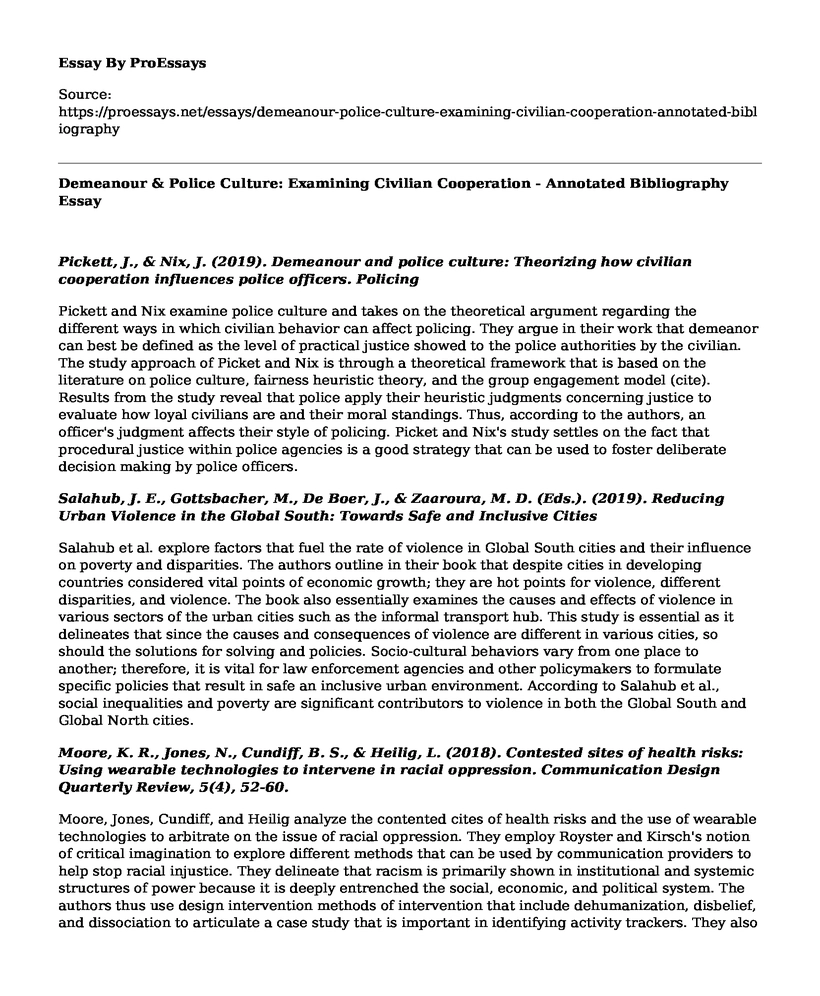Pickett, J., & Nix, J. (2019). Demeanour and police culture: Theorizing how civilian cooperation influences police officers. Policing
Pickett and Nix examine police culture and takes on the theoretical argument regarding the different ways in which civilian behavior can affect policing. They argue in their work that demeanor can best be defined as the level of practical justice showed to the police authorities by the civilian. The study approach of Picket and Nix is through a theoretical framework that is based on the literature on police culture, fairness heuristic theory, and the group engagement model (cite). Results from the study reveal that police apply their heuristic judgments concerning justice to evaluate how loyal civilians are and their moral standings. Thus, according to the authors, an officer's judgment affects their style of policing. Picket and Nix's study settles on the fact that procedural justice within police agencies is a good strategy that can be used to foster deliberate decision making by police officers.
Salahub, J. E., Gottsbacher, M., De Boer, J., & Zaaroura, M. D. (Eds.). (2019). Reducing Urban Violence in the Global South: Towards Safe and Inclusive Cities
Salahub et al. explore factors that fuel the rate of violence in Global South cities and their influence on poverty and disparities. The authors outline in their book that despite cities in developing countries considered vital points of economic growth; they are hot points for violence, different disparities, and violence. The book also essentially examines the causes and effects of violence in various sectors of the urban cities such as the informal transport hub. This study is essential as it delineates that since the causes and consequences of violence are different in various cities, so should the solutions for solving and policies. Socio-cultural behaviors vary from one place to another; therefore, it is vital for law enforcement agencies and other policymakers to formulate specific policies that result in safe an inclusive urban environment. According to Salahub et al., social inequalities and poverty are significant contributors to violence in both the Global South and Global North cities.
Moore, K. R., Jones, N., Cundiff, B. S., & Heilig, L. (2018). Contested sites of health risks: Using wearable technologies to intervene in racial oppression. Communication Design Quarterly Review, 5(4), 52-60.
Moore, Jones, Cundiff, and Heilig analyze the contented cites of health risks and the use of wearable technologies to arbitrate on the issue of racial oppression. They employ Royster and Kirsch's notion of critical imagination to explore different methods that can be used by communication providers to help stop racial injustice. They delineate that racism is primarily shown in institutional and systemic structures of power because it is deeply entrenched the social, economic, and political system. The authors thus use design intervention methods of intervention that include dehumanization, disbelief, and dissociation to articulate a case study that is important in identifying activity trackers. They also recommend the redesigning of the activity trackers that are responsible for finding solutions to these risks of dehumanization, disbelief, and dissociation. Accordingly, the research also denotes that tracker data is important as a source of testimony in courts. However, despite the importance of the tracker data, law enforcement such as the Fourth Amendment Law may offer protection to access to this kind of data difficult for investigation. From this study, Moore, Jones, Cundiff, and Heilig conclude that considering increased police brutality on Black Americans, these trackers are important in improving public health and the fight towards ending racial injustice.
References
Moore, K. R., Jones, N., Cundiff, B. S., & Heilig, L. (2018). Contested sites of health risks: Using wearable technologies to intervene in racial oppression. Communication Design Quarterly Review, 5(4), 52-60. Retrieved from https://www.researchgate.net/publication/323300703_Contested_sites_of_health_risks_using_wearable_technologies_to_intervene_in_racial_oppression
Pickett, J., & Nix, J. (2019). Demeanor and police culture: Theorizing how civilian cooperation influences police officers. Policing: An International Journal. Retrieved from https://www.researchgate.net/publication/329786987_Demeanor_and_Police_Culture_Theorizing_How_Civilian_Cooperation_Influences_Police_Officers
Salahub, J. E., Gottsbacher, M., De Boer, J., & Zaaroura, M. D. (Eds.). (2019). Reducing Urban Violence in the Global South: Towards Safe and Inclusive Cities. Routledge.
Cite this page
Demeanour & Police Culture: Examining Civilian Cooperation - Annotated Bibliography. (2023, Feb 20). Retrieved from https://proessays.net/essays/demeanour-police-culture-examining-civilian-cooperation-annotated-bibliography
If you are the original author of this essay and no longer wish to have it published on the ProEssays website, please click below to request its removal:
- Events that Led to DOJ Oversight in the Form of a Consent Agreement
- Essay Sample on Demilitarizing the Police
- House Price Dynamics and the Macro-Economy: An Emprical Perspective of Uae
- Essay on California's Deadly Wildfires: A Burning Issue for U.S. Government
- Essay on Community Policing: Building Relationships & Working Together for Public Safety
- Revolutionizing Transportation: Cars Since the Advent of Karl Benz - Research Proposal
- E-Scooter Sharing: The Solution to Last Mile Transport in NZ & AU - Essay Sample







